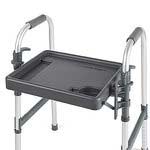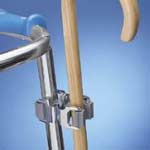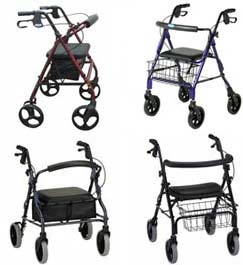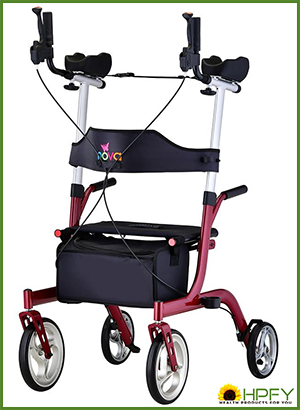Outdoor Rollator Walkers
Walkers with permanently attached wheels are known as rollator walkers by most companies these days. Rollator walkers have several standard features that are common among all the different models. The information on this page is on the models I consider "outdoor" models. They are generally a little heavier than the indoor models and have wheels that are more than 6" in diameter. The larger the wheels the easier they will roll over small obstacles. That is not to say they can't be used inside but the heavier, larger wheels may be difficult to get into smaller areas of some houses.
As with any other walker style, I feel the user should actually try the walker, or have previous experience with the style, they are purchasing for safety.
Common Features of Rollators
- Wheels - Rollator walkers, of course, always have wheels and, as mentioned above, the outdoor models have wheels larger than 6" in diameter. There will be two wheels on the front legs of the walker that swivel and, usually, two on the back legs that have some sort of braking system. Most of the outdoor rollator walkers will have solid tires so flat tires won't be an issue but a few may have air filled tires for a smoother ride on rough terrain.
- Brakes - Rollator walkers will also have a braking system similar to the hand brakes on a bicycle that will slow the walker or stop it when squeezed. In addition to working like conventional brake system rollator brake systems will have a way of being locked on for safety during different situations such as when the user is seated.
- Seats - All the rollators I know of have some type of seat. The seats are simple flat surfaces, usually padded, that can usually be flipped up to allow the user to walk within the walker instead of behind the walker. The seats are intended for sitting & resting, not for sitting on and pushing ones self around backwards with their legs and not for sitting on while someone else pushes the user around. The wheelbase of a walker is short and if the user is on the seat and the front wheels hit some obstacle the walker is likely to flip over forward causing injury to the user and damage to the rollator.
- Backrests - Walkers with seats also have some type of backrest. It will usually be a simple metal bar that has some padding on it. The back rest on a walker is not intended for support, but is intended to prevent the user from sitting too far forward on the walker and creating forward instability. It will also serve as a reminder that the user can not lean too far back which again will create some instability.
- Baskets and Walker Bags - Most rollators will have one or the other with some having both. They are usually mounted fairly low on the frame to enhance stability and can be mounted either on the front of the walker or under the seat. The can be a security issue if the basket is on the front of the walker because the user can't see it when seated. The "under-seat" baskets are much more secure but inaccessible when the user is seated. The user will have to decide which type is best for their situation.
- Folding Frames - Because it is expected by the manufacturer that these walkers will be taken to different locations and must be loaded into vehicles rollator walkers will all have some type of folding mechanism. Baskets and bags are always removable and may have to be to fold the walker. Generally these rollators can be folded by lifting on the seat mechanism which will also release the lock that prevents the walker from folding accidentally while in use.
Height Adjustment
Setting the proper height for a rollator walker is important for the comfort, safety and posture of the user. Generally the top of the walker's hand grips should be at the same height as the user's wrist where it meets the hand when the user is standing as upright as they can. The important thing is there should be a small bend in the user's elbow when using the walker.
Unlike the standard walkers where the handle height is adjusted by moving the wheels up and down, most rollator walkers are adjusted by adjusting the handles up and down.
How to Use a Rollator Walker
Using the rollator walker is pretty straight forward. The user has the walker in front of them, steps into it from the rear and pushes it forward at the same time. The pace is fairly conventional for walking instead of the stop and go pace of a standard walker without wheels. Because the front wheels will swivel, the walker should never have to be picked up by the user while in use.
The user can operate the brakes while walking to slow down and stop or locked on. The brakes should always be locked on when the user is in the process of sitting or standing, whether they are using the walker seat or another seating surface and when they are seated on the walker resting.
The seat on the walker is to be used for sitting and the walker should not be moved while the user is sitting on it. The brakes should always be locked on when the user is sitting.
The walker is not intended to take all of the weight of he user but some weight can be transferred off the legs when walking forward and providing balance when needed. Some people have trouble with rollators, especially the lighter models, because they can get away from people when they are using them. People with forward balance issues sometimes can have trouble because they push the walker too far forward, too fast and can't catch up with it. The faster they try and walk to catch up with the walker, the faster and farther away the walker goes. Traveling down ramps and hills may aggravate this behaviour.
Accessories Available
Because rollators have many features as standard equipment there are only a couple of accessories available for these walkers.
- Trays - While most of the rollator walker models do not offer trays as either optional or standard equipment, most rollators can be set up with some type of tray from after market manufacturers. Trays can be helpful for transporting meals or other items while moving around.
- Cup Holders - Cup holders are pretty much an after market item but really the only way to carry a drink on a walker without spilling it. One bump when carrying a drink on a tray and you'll be heading back to the kitchen for a refill.
- Cane Holders - One might wonder why a person using a walker would need to bring along with them but for those who are able to use a cane for short distances, but need a walker for longer distances, having a cane with them is an asset. Getting into a small bathrooms, voting booths, narrow aisles, change rooms and other small places is often difficult, if not impossible, for someone using a rollator walker.





 Online Vendors
Online Vendors  US Online Vendors
US Online Vendors 


